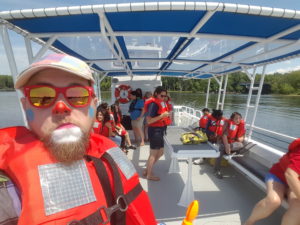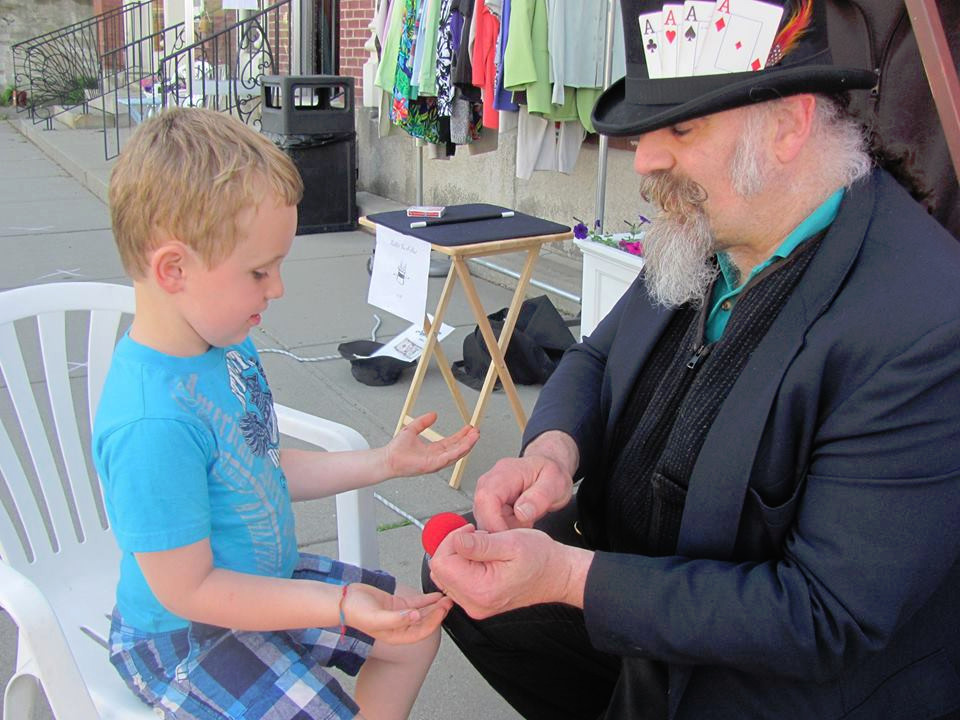Clients looking to hire a magician for their upcoming event normally have two options: strolling magic or a magic show.
We asked our resident magicians Kenny and James (as well as our booking agent Jessica) to help us explain the differences so every client can book the best fit for their upcoming event.
What is the difference between strolling magic and a magic show?
James: In a magic show, there’s a boundary between the “stage” area and the “audience” area. While volunteers from the audience are often invited up on stage, and the magician frequently makes forays into the audience, there’s a demarcation. The stage (or “platform” or “parlor”) magic show is longer — often half an hour or 45 minutes — with several routines consisting of several tricks, to provide a cohesive whole with a theme. Think of a one-act play.
In strolling magic, the magician approaches individuals or small groups (three to five folks, typically) to present one to three tricks. The magic is more like a conversation than a stage play. Often the members of the audience touch and examine the props, and the magic itself takes place in the spectators’ hands. People sitting a dinner, folks waiting in line for some other event, people standing about — they are the ones who have a bit of magic touch their lives. It’s up close and personal.
Kenny: My personal show is a 50/50 mix of comedy and classic magic with a twist of clown charm. You can expect to see me on a stage while I go through one trick after another with plenty of helpers and laughs. Like most magicians, every show I do is largely the same with some adjustments for the event.
My strolling magic is more clowning around. I do plenty of magic, but can cater each interaction to the event and individuals there. That might be some puppets, juggling, clown gags, balloon twisting, or anything else–all depending on what I think will work best for the audience.
What audiences does *your* strolling magic land best with?
James: For me, it’s often folks above the age of six or seven, though young adults through twenties seem to enjoy it most.
Kenny: My strolling magic is great for all ages, like an animated movie that’s made for kids ages 5-9 but has plenty of jokes and puns for teens and adults.
When would you recommend strolling magic over a show?
James: Would having everyone sit in rows looking in one direction fit in with your plan for the event? Then go with a show. A corporate dinner and awards presentation, for example. If you have more freedom of motion, mingling, and random movement with no fixed schedule for various phases of the day, go with strolling.
Kenny: I recommend strolling magic for fairs & similar big events where there is 100s off people to entertain a few at a time
Jessica: In my experience planning events with clients, event organizers who don’t have a formal schedule for their event often like the flexibility of having a magician wander through the audience.
When would you recommend a show over strolling magic?
James: When there’s a schedule, when you expect folks to be all in one place at one time, then go with a show. If it’s mingling/freeform, then go with strolling.
Kenny: Private parties, corporate events, big events if there is ample seating.
Jessica: Clients who are booking entertainment with the goal of keeping kids contained often prefer a show so the kids can sit down while parents talk amongst themselves (or also hang out and enjoy the show!
About how many guests will interact with you an hour?
James: For a show — all of them, all at once. For strolling, probably forty people an hour will be directly involved, with as many more looking on as random chance may provide.
Kenny: In a strolling set I can entertain 15-30 people, depending on how amped up the kids or adults are.
What sort of tricks should guests be ready to see in *your* strolling set?

James: Folks should expect to see dice, coins, rings, strings, dollar bills. They’ll see classic sleight-of-hand using ordinary objects. They’ll experience the magic in their own hands.
Kenny: Gravity manipulation with water, magic bags they can reach into, a cheeky puppet named Sherbert, ball juggling, and of course plenty of clowning around!
Tags: ct, ma, RICategories: 6-9, classic circus, magical, marketing & promotional, Party Planning Help




